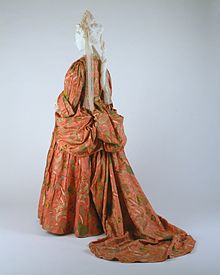Manteau
Manteau (from French "coat") is the generic term for the coat-like lady's robe of the late 17th and 18th centuries, also known as robe . In a narrower sense, it refers to a certain form of clothing that developed around 1680 as Deshabillé . In German it was called Aufstecke-Kleid ( Frauenzimmer-Lexicon , 1715).
The back and front part of the mantle were generously cut and only brought to the figure by means of folds.
The folds were held in place by a belt, sometimes also by hidden basting stitches, the skirt was pulled up on the side and fastened at the back with loops over two buttons attached in the cross, so that the train flowed onto the floor in "waterfall folds". Hip pads were worn underneath, and around 1710 the very first conical paniers . Shortly thereafter, this form of the manteau died out in France and gave way to the contouche .
In England, the manteau lived on in evolving forms under the name of Mantua . From around 1770, the changed taste of the French rediscovered the manteau, and they re-imported it under the name Robe à l'anglaise .
- Manteau and skirt of striped brown English fabric with gold and silver embroidery, about 1690 to 1695



